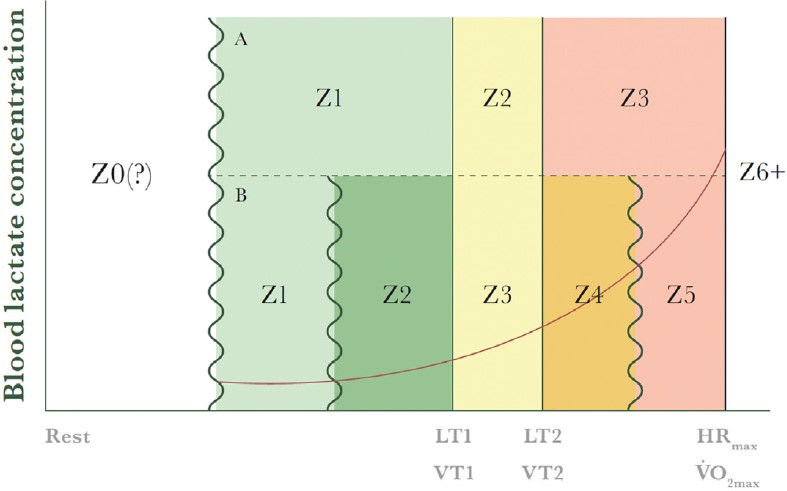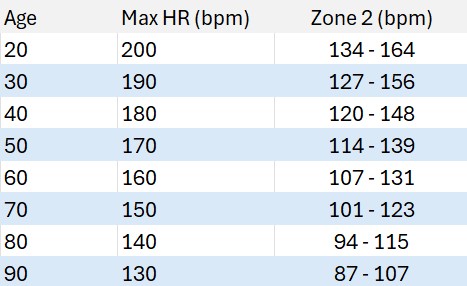It’s plastered on the walls, shouted from the rooftops and pushed down your throat by every running influencer in 2025. So, what is it? And will it magically help you run, or cycle faster? The short answer is no, it’s no magic bullet. Zone 2 training will not take your half marathon time from 2:00 to 1:20. Nor will it let you run a 5km race with an average heart rate of just 130bpm. And most importantly it will not cut your weekly training time in half.
So, what is zone 2? How important is it? And if you choose to train in it, how do you do it?
What is Zone 2 training?
Zone 2 training is exactly what the name suggests. It’s doing exercise while remaining in your second intensity zone. But is it calculated on 3 intensity zones, 5 zones, or as many as 7 zones. To understand intensity zones, it’s important to take a crash course in exercise physiology.

As exercise intensity increases, so too does the metabolic demand for energy. To produce energy your body requires oxygen and a substrate (think food source). At rest and low intensity exercise, the substrate is fatty acids. At moderate intensity exercise, it’s a mix of fatty acids and lactate, and at high intensity it’s almost exclusively lactate. The point at which blood lactate levels rise above resting levels is called Lactate Threshold 1 (VT1). The point at which lactate is being produced more rapidly than the body can utilise it is called Lactate Threshold 2 (LT2).
These two thresholds (LT1 and LT2) are clearly defined and form the basis for all intensity zone scales.
It’s also important to note that the Lactate Thresholds are also called Ventilatory Thresholds (abbreviated VT1 and VT2). They are synonymous, but here we will stick with LT1 and LT2. A more in-depth look at these zones can be found elsewhere. But for now, we will focus on the essential LT1.
“Zone 2 training is defined as low-intensity endurance training at an intensity just below LT1 and is one of the foundational zones in endurance training.”
Given this definition, it is clear that zone 2 refers to the 5 zone intensity model. Intensity remains close too, but immediately below LT1. Given what we know about substrate use at low intensity exercise, this intensity will utilise fatty acids as a substrate and not elevate lactate levels.
How important is it?
Contrary to popular belief zone 2 is only moderately important for recreational athletes. The most frequently listed benefits include increased muscle capillarisation, increased mitochondrial enzymes in type I muscle fibers, improvements in metabolic efficiency, and a modest increase in critical power and VO2max.
Zone 2 training will also increase LT1, meaning your intensity can be higher before you reach the first threshold. This occurs because your body adapts to the training stimulus. If you train below LT1, then your body will get really good at exercising at a low intensity by utilising fatty acids more efficiently. This is very important in long races such as half ironman or longer. Most importantly, however, you can do large volumes of low intensity training with very low injury risk. It’s this large volume that is the key to zone 2 training. It causes some of the essential cardiovascular adaptations required for endurance sports at minimal risk. More volume equals more adaptations, equals better performance.
These cardiovascular benefits are not unique to zone 2 training. Higher or lower intensity sessions will also produce many of the same adaptations. Research also shows that the most important measure of endurance sports is VO2 max. Studies that compare zone 2 training with interval training three times a week show that interval training is vastly superior for increasing VO2 max. Unless you’re training more than 4 times a week, zone 2 training has limited benefits for you. You would be better off doing intervals.
Where does it belong?
So where should zone 2 fit into your training? Roughly every second day you should be doing a hard session in the moderate-high intensity zones. These sessions help you get faster, stronger, fitter and more resilient. Hard sessions require a longer recovery as your body repairs the microscopic damage induced by the session. Recovery days are extremely important. This is where your zone 2 should be, on the recovery days. The other place for zone 2 training is for very long sessions such as cycling or running over 2 hours duration. These long sessions promote the efficient use of fatty acids for energy. When training for long races such as half or full ironmans these sessions become more important.
How to train in Zone 2
There are many different methods athletes use to track their intensity. The most popular being heart rate and the conversation test. The most accurate and only definitive way to measure is by doing a blood lactate test.
Heart rate max is roughly calculated as 220 minus your age. So, a 25 year old athlete would have a theoretical max heart rate of 195. Your zone two is estimated to be around 67%–82%. Here is the quick conversion table to help with the calculation. Remember it’s a rough guide only.

The conversation test refers to the ability to comfortably chat with someone while exercising. Researchers tested it’s validity and found it is quite an accurate indicator of intensity. You should be able to speak full sentences without gasping for breath. Think of this as the perfect opportunity for a social catchup run.
Finally, the only precise way to find your LT1 is by doing an incremental exercise test while testing blood lactate levels. This is expensive and usually done through a training block to track improvements in fitness. Blood lactate levels of 1.0–2.0mmol/L would indicate zone 2. If you don’t have the funds or inclination to bleed for the sake of your training, I’d recommend sticking with the previous two methods which are quite reliable.
Conclusion
Zone 2 is based on a 5 zone training model. The intensity is low enough that it doesn’t cause an increase in lactate levels, indicating that it is below LT1. This training causes cardiovascular adaptations but is not as effective as interval training or threshold training for many important adaptations. Zone 2 training is very low injury risk which allows you to perform high volumes on consecutive days. It’s a useful adjunct to interval, VO2max, threshold, tempo and strength training in an athletes training tool kit. Using zone 2 in addition to higher intensity training methods is beneficial for recreational athletes.
Sources:
Stiko et al 2025, What Is “Zone 2 Training”?: Experts’ Viewpoint on Definition,
Training Methods, and Expected Adaptations
Coyle E F 1999, Substrate utilization during exercise in active people
Milanović et al 2015, Effectiveness of High-Intensity Interval Training (HIT) and Continuous Endurance Training for VO2max improvements: A Systematic review and Meta-Analysis of controlled trials

Leave a Reply